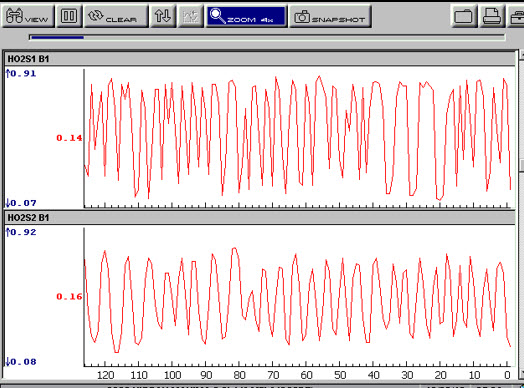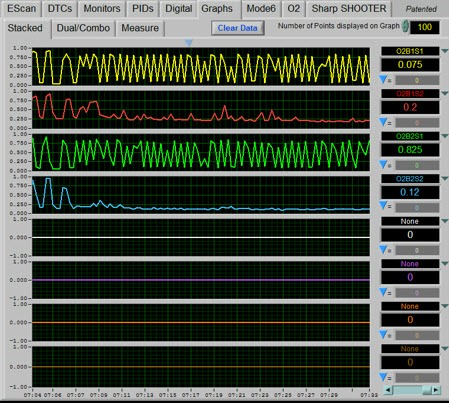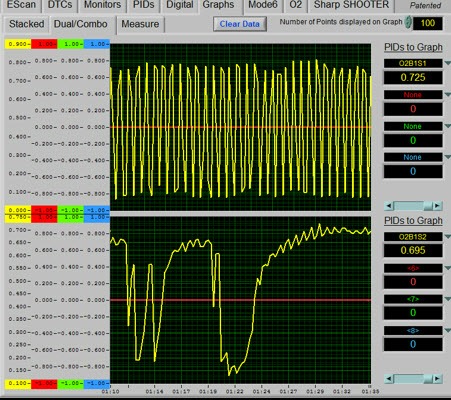How to Diagnose a bad catalyst
2017 Update Class
Some of the Images are from your Smog License Update Class manual by AGT Training
I know coming from work and setting in a class lecture can be hard but I appreciate your effort.
This is the lecture from class repeated just encase you came in late or dose off LOL.
How to Diagnose a bad catalyst:
When the air/fuel mixture is lean, the catalyst will store extra oxygen. The O2 sensor will report to the PCM "Power Train Control Module" a lean condition with a low voltage.
The PCM response would be to increase the injector pulse to drive the O2 sensor voltage high "Rich command."
This CO increase would be enough for the Rhodium within the catalyst to react to cause a reduction in Nox.
How about HC and Co
How about the HC and CO, how are these polluters reduce, since the air/fuel mixture went rich the oxygen that was stored from the previous cycle is now released, to help oxidize HC and CO at the same time Nox is being reduced.
Now you can see this is why it's very important that the O2 sensor is working correctly before you diagnose bad catalyst.
REAR O2 SENSOR
If you don't know, already the front O2 sensor should be driven rich "900mv" back to lean "100mv" and cycling back and forth.
This cycling of the 02 sensors indicates close loop and a balance air/fuel mixture.
Now think about this a catalyst is a storage tank for oxygen meaning the catalyst should store and use up all the oxygen.
So if you are going to diagnose a bad catalyst you have to understand there should be no or very little O2 coming out the rear of the catalyst.
If the catalyst is releasing an excessive amount of O2, either too much went in, or the catalytic converter can not store it any longer.
Yes if too much O2 goes into the catalyst it can not hold it all, once the cat reaches its capacity, any additional O2 will be released through the rear.
So how can you check if the catalyst no longer can store 02, look at the rear O2 sensor?
If the catalyst is working the rear O2 should be flat or steady.
If the O2 sensor in the rear is switching with 70% of the front, this may indicate a bad catalyst or a cat that's not efficient.
Is there another test you can perform to diagnose a bad catalyst?
Oxygen storage capacity test (OSC) is one.
Many manufacturers run this test it will enriching the air/fuel mixture at this point the catalytic converter will try to oxidize the CO and empty itself from the O2 that's already embedded within it.
Then the PCM will switch lean to fill up the catalyst again. Now the catalyst can only hold so much O2 before the O2 is push pout the rear of the catalytic converter.
Let's back up a second when the mixture went rich both O2 sensors are now reading a rich indication front and rear. When the PCM commanded a lean condition the front O2 sensor voltage drops first now since the catalyst has to fill up before the rear O2 sensor voltage drop, there should be a delay of 2 seconds are more.
Anything less than 2 seconds indicates a possible weak catalytic converter.
SWITCH RATIO
An O2 sensor shouldn't be tested at idle; it could give you a false reading. Hold the RPM at 2,000 RPM's for 2 minutes and watch the front and rear O2 sensors.

IMAGINE BY AGT TRAINING
There should be a 70% difference from the front 02 and the rear O2. If the front O2 sensor switches 100 times "which is more accurate." the rear should O2 sensor should change less than 70% less.
If they are equally matching it could indicate a weak or defective catalytic converter.

IMAGINE BY AGT TRAINING
If you test a cold catalyst for the switch ratio, and I have done this you will get a bad test result, especially if it's performing at idle.
I had the service writer on the phone ordering the part before I stop him from completing the order when I made this mistake.
I tell all my students to test the catalytic converter at 2,000RPM's

IMAGINE BY AGT TRAINING
HOW ABOUT THE OSC TEST
Yes, you can get a false reading on this test also, think about this, if the catalyst only holds a certain amount of 02 and too much goes in the excessive will come out the rear and giving you a false reading.
I have seen worn plugs, cold engine, a lazy O2 sensor, exhaust leaks and a misfire all set a P0420 code.
Oh, I forgot a Toyota Mass Air Flow Sensor the second sensing wire I didn't know it had was dirty and gave me a fail catalytic converter test and DTC.
I'll appreciate you for reading my material if you like the information, please click the LIKE BUTTON.
CLASS SCHEDULES
Emission Control 1:
B.A.R. Smog Check
Inspector Level 1
(Inspector "Smog" License):
Engine Fundamentals
8am - 12:15 pm
Summer Class
7/5/2022 -8/5/2022
Class # 799065
Emission Control 2:
B.A.R. Smog Check
Inspector Level 2
(Inspector "Smog" License):
Rules and Regulations
8am - 12:15 pm
Summer Classes
7/5/2022 - 8/5/2022
Class # 799067
Engine Performance 1:
8am - 12: 15 pm
Date: TBD
Class # 799069
Engine Performance 2:
B.A.R. Specified Diagnostic
and Repair Training
(Repair "Smog" License)
Time: TBD
Date: TBD
Class # 799071
Emission Control 1
(Inspector "Smog" License):
5:00pm - 8:45 pm
Date: TBD
Class # 799065
Emission Control 2:
(Inspector "Smog" License):
5:00pm - 8:45 pm
Date: TBD
Class # 799065
Exhaust Emissions (Update Class):
5:30 pm - 8:45 pm
Tuesday nights:
Dates: coming soon
Class # 796070